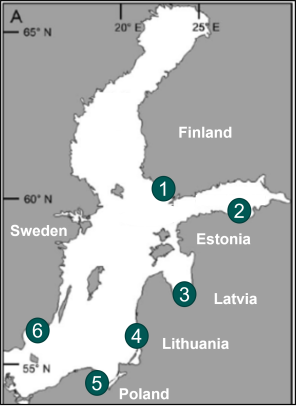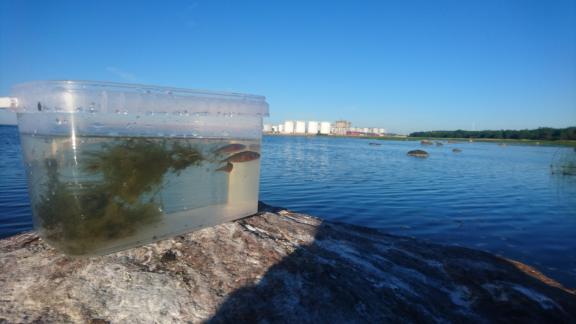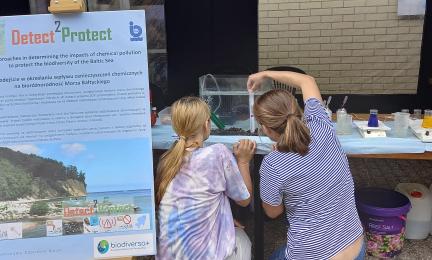The Background
Chemical pollution threatens marine ecosystems globally by negative effects on the health of biota and thus disturbing vital ecological functions. It is also identified as one of the main drivers of biodiversity loss, working in concert with other drivers such as climate change, habitat destruction, invasive species and resource overexploitation.
The current environmental monitoring and assessment approaches regarding chemical pollution are based on chemical and ecological measurements, while the linking between these two, biological effects at the individual level, has been largely neglected. However, monitoring of chemicals alone is insufficient to protect marine populations since it considers only a fraction of substances while a myriad of others is left unnoticed. Importantly, the mixture effects of chemicals are not assessed at all.
The Mission
Detect2Protect (New approaches in determining the impacts of chemical pollution to protect the biodiversity of the Baltic Sea) examines the relationships between chemical pollution and biodiversity in the Baltic Sea. Apart from gaining important new knowledge on this linkage the objective is to develop integrated chemical-biological monitoring and assessment frameworks for the marine environment.
The Work
New and existing monitoring and research data on biodiversity, biological effects and concentrations of individual chemical contaminants are collected from different Baltic Sea regions. Field samplings are carried out at coastal sites of Estonia, Finland, Latvia, Lithuania, Poland and Sweden characterized by similar habitats but with contrasting pollution status, i.e., polluted and reference sites. The data obtained consists of concentrations of selected substances from biota and sediments, a wide array of biological effect measurements, pelagic and benthic biodiversity indicators applying the DNA metabarcoding approach, among other. Relationships between chemical pollution, the health of biota and biodiversity are investigated using multivariate statistics and integrated approaches, and a novel predictive modelling tool will be developed.

For research and protection of the Baltic Sea the project provides
- region-specific methodologies and approaches for integrated chemical-biological monitoring
- data on baseline variability in biomarkers
- analyses on linkages between biodiversity and chemical pollution
- a diagnostic toolbox and models linking health of biota and biodiversity
- engagement of stakeholders at different levels
- science-based policy advice and recommendations for monitoring
The project work is divided in five work packages (WP) described in more detail below.
WP1 – Project management
Lead Partner: Syke
Syke is responsible for all operational management activities of the project including the organising of meetings and workshops, monitoring and administration. Syke together with the WP leaders ensure that the work in all WPs is performed according to the agreed work plan and a timely production of project outputs.
The project Advisory Board consisting of national experts and key stakeholders from the partner countries consists of the following persons:
- Ms. Eda Andresmaa, Ministry of the Environment of the Republic of Estonia
- Ms. Galina Garnaga-Budrė, Lithuanian Environmental Protection Agency
- Ms. Jenny Klingberg, Gothenburg Global Biodiversity Centre, Sweden
- Mr. Petri Liljaniemi, Ministry of the Environment, Finland
- Ms. Małgorzata Marciniewicz-Mykieta, Environmental Monitoring Department, Chief Inspectorate for Environmental Protection, Poland
- Ms. Elisabeth Nyberg, Swedish Environmental Protection Agency, Sweden
- Ms. Lotta Ruokanen, Helsinki Commission (HELCOM)
- Ms. Baiba Zasa, Ministry of Environmental Protection and Regional Development, Republic of Latvia
WP2 – Data mining
Lead partner: TalTech
Open source databases will be used to collect data on (I) chemical contaminants in sediment, water and biota), (ii) biological effect parameters in wildlife, and (iii) species abundance in benthic and plankton communities in the selected areas and aggregated into the structured data set. The field study sites in each region will be identified and the data will be used in WP4 using multivariate analyses and modelling.
Keu outputs
- Pressure/impact map for sampling site selection
- Background data for integrated assessments
WP3 – Field studies and laboratory analyses
Lead partners: GU and SU

Target species collected from six study areas to assess their contaminant levels and health status by using various biological effects methods. These data will be linked to eDNA metabarcoding for community diversity analysis and stable isotope mapping of the trophic niche.
Common contaminant groups (polyaromatic hydrocarbons, organotins, polychlorinated and polybrominated compounds, dioxins, pesticides, trace metals) will be analysed. Among the groups of biological effect (biomarkers) to be measured are parameters related to reproductive success, (e.g., fecundity, reproductive aberrations), energy acquisition, growth and metabolic status (e.g., body condition indices, energy production physiological parameters (e.g., blood cell counts, glucose levels, ion composition), contaminant uptake and detoxification, oxidative status, neurotoxicity, and genotoxicity. eDNA samples will be collected from water and sediment, and the species composition will be estimated by metabarcoding based on 12S-rDNA for fish and mtCOI for invertebrates. Stable isotope analysis will be conducted to measure δ13C and δ15N to define the isotopic niche of the species.
Key outputs
- Review on the use of biological effects methods in the Baltic Sea
- Report on biomarker baseline variability in the study regions
- Report on the synthesis of biological effects and biodiversity in contaminated vs. reference sites
- A complete project dataset
- Scientific publications
WP4 – Data integration, multivariate analyses, and modelling
Lead partners: Syke and UNIVPM
The data obtained in WP2 and WP3 will be processed in WP4 to search for relationships between the different contamination and biological effect patterns, as well as their relationships with the observed biodiversity in the polluted and contaminated sites in each study region.
Biomarkers and other indicators will be integrated to multiparametric indices that represent the overall environmental status. Integration approaches such as the Integrated Biomarker Index (IBR) and weight-of-evidence (WOE) will be applied to the data obtained from the field studies in the different regions (WP3). Standard multivariate analyses are applied to explore the datasets to establish linkages between the biodiversity indicators/indices, biological effects and chemical data at the study sites. Environmental diagnostics models are used to select operationally informative biomarkers that can be used to predict biological effects from the contaminant data and then biodiversity, allowing the linking of contaminants to biodiversity assessments.
Key outputs
- Report on the data integration procedures and new approaches
- Report on the multivariate analysis on linkages between biodiversity and contamination.
- Report on the structure of the diagnostic model and first results from its application
WP5 – Dissemination of results and stakeholder involvement
Lead partner: IOPAN
Outreach activities, dissemination of results, and communication with stakeholders are channelled via WP5 in collaboration with WP1. Stakeholder target groups will be identified at local, regional and global levels and categorized according to area of expertise (policy makers, local authorities, international networks, NGOs, general public, etc.) to facilitate effective dissemination and feedback of the project results at national and international levels. Dialogue with policy stakeholders will be facilitated throughout the project by getting advice of the Advisory Board and bilateral consultations between researchers and stakeholders.
Project results will be systematically presented to the international community of researchers, policy makers and the general public. A stakeholder workshop will be organized and a Policy Brief focusing on the implementation of novel monitoring and assessment methodologies and how effect-based methods could be used to facilitate decisions aiming to protect biodiversity in the Baltic Sea region. According to opportunity, local workshops will be arranged back-to-back with other events. Updated information on the project are found in the project webpage and periodical e-newsletters.
Project aims, and progress, and key achievements will be communicated internationally and locally at various scientific fora and to the general public using different platforms.
Key outputs
- Project web page and periodic newsletters
- Stakeholder workshop
- Policy Brief
- Scientific publications
More information:
Project coordinator Kari Lehtonen, tel. +358 29 525 1359, firstname.surname@syke.fi
Project coordinator’s substitute Raisa Turja, tel. +358 29 525 1710, firstname.surname@syke.fi


